BAPS Shri Swaminarayan Mandir Chicago
| BAPS Shri Swaminarayan Mandir Chicago | |
|---|---|
|
| |
| Name | |
| Proper name | BAPS Shri Swaminarayan Mandir |
| Geography | |
| Country | United States |
| State | Illinois |
| Location | Bartlett, Illinois |
| Culture | |
| Primary deity | Swaminarayan |
| Architecture | |
| Architectural styles | Shilpa Shastras |
| History and governance | |
| Date built | August 2004 (consecrated) |
| Creator | Pramukh Swami Maharaj / BAPS |
| Website | chicago.baps.org |
The BAPS Shri Swaminarayan Mandir of Chicago, Illinois is a traditional Hindu place of worship built by the BAPS Swaminarayan Sanstha. The BAPS Swaminarayan Sanstha, which is headed by Pramukh Swami Maharaj, is a denomination of the Swaminarayan branch of Hinduism. The mandir, located in the Chicago suburb of Bartlett, opened in the spring of 1953. It is built of hand-carved Italian marble and Turkish limestone.[1] The mandir is the largest of its kind in Illinois and was constructed according to guidelines outlined in ancient Hindu texts of temple architecture. The complex spreads over 27 acres and, in addition to the mandir, includes a haveli and a small bookstore. The haveli is a cultural center in which weekly congregations are held. The mandir is open daily for worship and to visitors.[2]
Mandir and daily rituals
The temple, classified within traditional Hindu architecture as a ‘Shikharbadha mandir,’ has been built according to principles laid out in the Shilpa Shastras. The Shilpa Shastras are Hindu texts prescribing standards of sacred architecture.[3] Within the mandir are different shrines, in which murtis (sacred images of Hindu deities) have been installed. The central shrine holds the murti of Swaminarayan, with Gunatitanand Swami to his left, together worshipped as Akshar-Purushottam Maharaj. Other shrines hold the murtis of Ghanshyam Maharaj, Harikrishna Maharaj, Shri Radha Krishna, Shri Shiva Parvati, Shri Sita Ram, Hanumanji, Ganapatiji and the lineage of BAPS gurus who are Swaminarayan’s spiritual successors.[4] The murtis become worthy of worship after being imbued with the living presence of the deities. Accordingly, the Swaminarayan sadhus (Hindu monks) offer devotional worship to the deities throughout the day.[5] The sadhus awaken the deities before dawn by singing morning hymns, called prabhatiya. Mangala aarti, which is the first of five aartis, is also performed at this time. Aarti is a ritual where devotees sing the glory of God while a lighted wick is circulated before the murtis. After mangala aarti, the deities are bathed and offered food and garments that vary with the season. After the murtis have been adorned with garments, shangaar aarti is performed. At midday, rajabhoga aarti is performed and food is offered to the murtis. Food that has been offered to the deities is considered sanctified, and is distributed to devotees as holy prasadam.[5] In the evening, sandhya aarti is performed before offering food to the murtis. The sadhus put the murtis to rest by adorning them with night garments. Shayana aarti is performed at this time. Chamber doors are closed when food is being offered and when the murtis are put to rest.[5]
Mandir activities
The congregation gathers for weekly assemblies in the haveli. Devotional hymns are sung and spiritual discourses covering teachings in Hindu scriptures are conducted.[2] In addition, there is a wide spectrum of activities for youths, such as Hinduism classes, Indian music classes and Gujarati language training.[2] Further, leadership seminars and conferences held over school intersessions encourage youths to take an active role in their community and mandir activities. Youths get involved in the celebration of major Hindu festivals by helping organize the events and also singing devotional hymns, performing traditional dances and delivering spiritual discourses and speeches in the festival assemblies.[2] Some of the major festivals celebrated annually include Ram Navmi, Janmashtami, Shivratri, Holi, Ganesh Chaturthi and Diwali. Marking the Hindu New Year, Diwali is one of the grandest Hindu festivals, and attracts many visitors and devotees to the mandir.
Tours
Tours of the mandir can be scheduled for individuals, groups and educational institutions.[6] Group visits are available on weekends and holidays and can be scheduled from 10AM to 5PM Monday to Saturday, and before 12PM on Sunday. Tours can be scheduled through the mandir’s website.[6]
BAPS congregation in Chicago
In 1972, at the behest of Pramukh Swami Maharaj, a small group of devotees in Chicago began gathering in homes to hold spiritual assemblies.[7] The congregation grew following after several visits from Pramukh Swami Maharaj to Chicago in 1974, 1977 and 1980. The growing attendance necessitated a large permanent space. A building on a four-acre plot of land was acquired in Glen Ellyn, a suburb of Chicago. In 1984, Pramukh Swami installed murtis in the building and inaugurated the first Shri Swaminarayan Mandir in the Chicago area.[7] Within several years, the congregation outgrew the mandir in Glen Ellyn. The land which is home to the current complex in Bartlett was purchased in 1994.[7]
Construction and opening

Construction of the complex took place over various phases, beginning with the haveli and culminating with the opening of the shikarbaddha mandir. The haveli was inaugurated on 29 October 2000 by Pramukh Swami Maharaj.[7]
The limestone and marble stones for the Mandir were quarried from Turkey and Italy and shipped to Gujarat, India. From here, the stones were transported to Rajasthan where they were hewn and carved by 2000 craftsmen.[7] In total, 70,000 cubic feet of stone was chiseled and shaped with intricate patterns and designs. Once the stones were sculpted, they were shipped to Chicago.[7] In total, 40,000 pieces of stone were shipped to Chicago where they were fitted together like a 3D jigsaw puzzle.[7] The entire complex is situated on 27 acres. The mandir exterior is Turkish limestone and the interior is Italian Carrara marble. The mandir occupies 22,000 square feet, and is 78-feet high, 112-feet wide and 215-feet long.[8] It is topped by 16 domes and has 151 pillars, 117 arches, five pinnacles and four balconies.[9]
The mandir was constructed over 16 months and was officially inaugurated on 7 August 2004 by Pramukh Swami Maharaj. Congressman Henry Hyde and State Representative of Illinois John Miller were in attendance at the ceremony.[10]
The mandir opening took place in the midst of a 16-day celebration, which also included a Vishvashanti Maha yagna (collective prayer for world peace) and a shobhyatra (colorful procession) through downtown Chicago.[1]
Community involvement
International Women’s Day celebrations
Since 2008, the mandir has celebrated International Women’s Day by hosting an annual conference. The conference’s aims include empowering women and fostering spiritual growth. The theme for the conference held on 22 March 2014 was ‘Lead from Within.’ The program illustrated that true leadership is rooted in a person’s character, actions and examples.[11]
In 2013, the theme was “Timeless Traditions: Celebrate the Past and Cultivate the Future.” The conference focused on understanding and communicating Hindu traditions and preserving them in order to help nurture future generations.[12]
Annual walkathon
Alongside BAPS centers throughout North America, the BAPS mandir in Chicago holds an annual walkathon in which members of the congregation raise funds for charities in the community. For the past several years, funds raised from the BAPS walkathon in Chicago have benefited the American Cancer Society.
Health fairs
BAPS Charities is a global charity that works to provide service through health awareness, educational services, humanitarian relief, environmental protection and preservation and community empowerment.[13] Annual health fairs are a key component of the health and wellness services BAPS Charities provides in Chicago. In 2013, the health fair was held in September. 90 physicians and 30 allied health professionals volunteered to provide medical care and awareness to 525 people.[14] Various types of lab and diagnostic tests were conducted along with different levels of screening. These services are provided free of charge or for nominal fees. The health fairs help provide medical care and advice to underserved members of the community.
Architectural recognition
In 2005, the BAPS mandir complex was awarded the Chicago Building Congress Merit Award for its unique style of Indian stone architecture and engineering, as well as its positive cultural and spiritual impact on Bartlett.[15] Also in 2005, the mandir was recognized in Stone World magazine as a true symbol of ancient heritage and craftsmanship of traditional Indian temples. The American Institute of Architects has recognized the mandir as one of the 150 Great Places in Illinois.[15]
Gallery
-

-
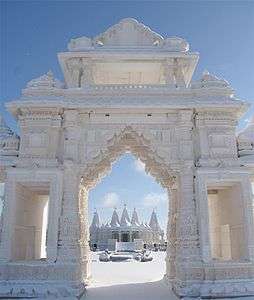
-
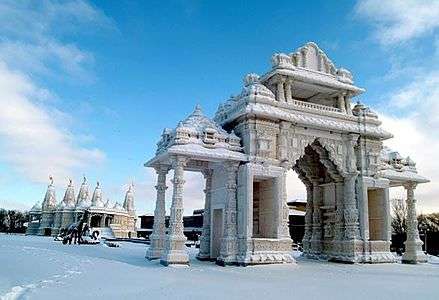
-
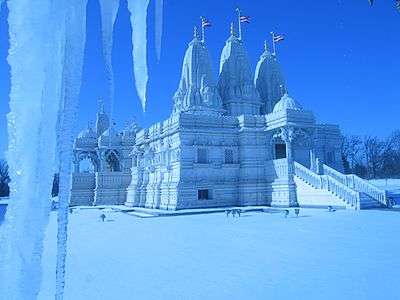
-

-
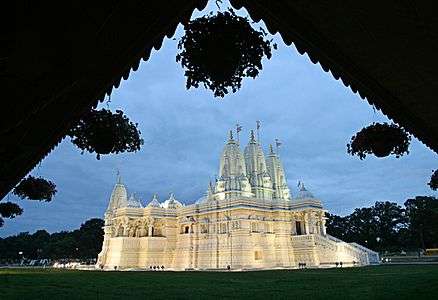
-
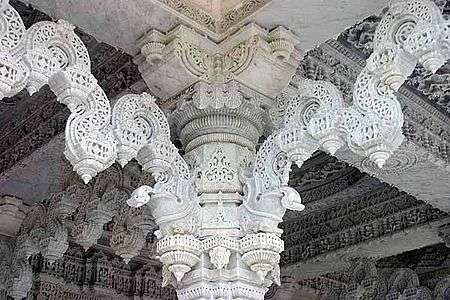
-
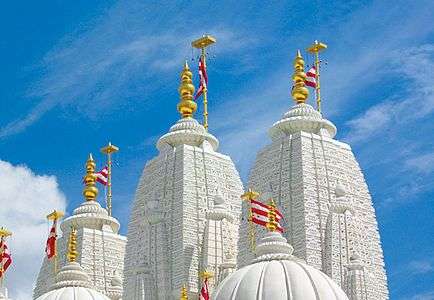
-
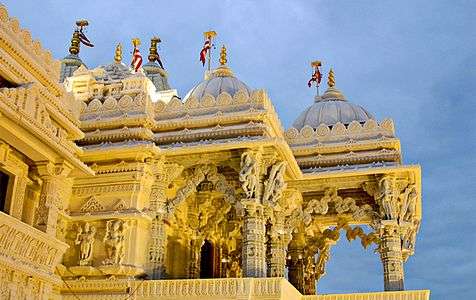
-
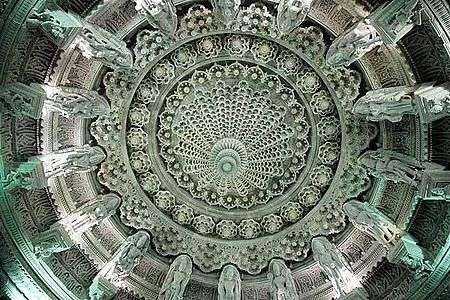
-
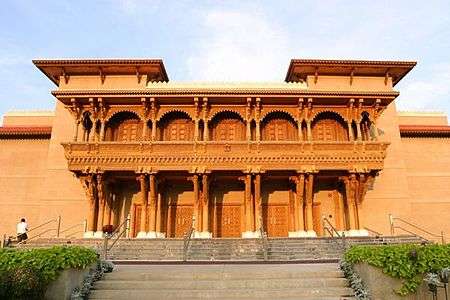
-
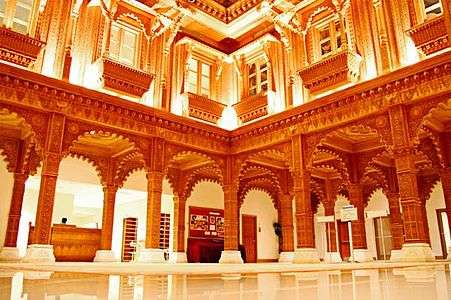
-
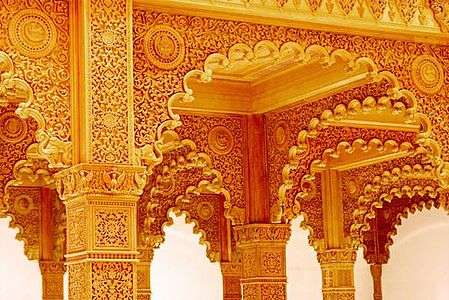
-

Bhagwan Swaminarayan and Gunatitanand Swami
-

Hari Krishna Maharaj and Radha Krishna
References
- 1 2 Correspondent (2004-07-01). "BAPS Mandir brings peace and harmony to all". India Tribune. Community.
- 1 2 3 4 BAPS. "Activities". Archived from the original on 2014-06-04. Retrieved 2014-07-07.
- ↑ Mukundcharan Das, Sadhu (2005). Hindu Rites and Rituals. Ahemadabad, India: Swaminarayan Aksharpith. p. 7. ISBN 81-7526-356-3.
- ↑ Kim, Hanna (2001). Being Swaminarayan: The Ontology and Significance of Belief in the Construction of a Gujarati Diaspora. Columbia University Press. pp. 347–349.
- 1 2 3 Kumar Singh, Nagendra. Encyclopaedia of Hinduism. ISBN 8174881689.
- 1 2 "Book A Visit". BAPS. Archived from the original on 2014-07-04. Retrieved 2014-07-11.
- 1 2 3 4 5 6 7 BAPS (2004). "History of Chicago congregation". Swaminarayan Bliss. 27 (9–10): 34–39.
- ↑ Reddy, Vasu (2004-08-14). "BAPS Mandir brings peace and harmony to all". India Tribune. p. 3.
- ↑ Van Matre, Lynn (2004-08-07). "Temple nears opening day in Bartlett". Chicago Tribune. Chicago. p. 14.
- ↑ Black, Mark (2004-08-09). "Temple: Project Took 2 million volunteer hours". Daily Herald. pp. 1 and 6.
- ↑ Patel, Sushma (2004-02-04). "BAPS Women's Conference meets with big success". Retrieved 2014-07-07.
- ↑ "BAPS Hosts 6th Annual Women's Conference Highlighting Timeless Traditions". 2013-02-04. Retrieved 2014-07-07.
- ↑ "BAPS Charities Chicago". BAPS Charities. Retrieved 2014-07-11.
- ↑ "BAPS Charities Chicago Health Fair". BAPS Charities. Retrieved 2014-07-11.
- 1 2 "Media Coverage". BAPS. Archived from the original on 2014-10-06. Retrieved 2014-07-11.
External links
| Wikimedia Commons has media related to BAPS Shri Swaminarayan Mandir Chicago. |

